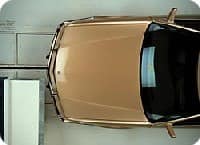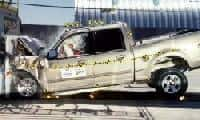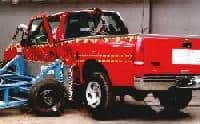The sleek lines and eye-popping color of your new car may cut an impressive figure on the road, but it might not have been your safest choice. If you’re searching for a good car insurance quote, a safe car could be your ticket.
|
IIHS’s frontal-offset crash test at 40 mph.
|
Is the car’s frame solid enough to withstand a side collision with a sport-utility vehicle? Will its seat-belts and airbags protect you from a head-on crash into a tree or other fixed object? Two agencies — one private and one public — have sought answers to these questions by conducting simulations of real-world traffic accidents and issuing safety ratings on new and used cars. The now-familiar “crash-test dummies” sit in for real drivers and passengers and sustain mock injuries.
“Designing a car for crash safety is a lot like packing a fragile item to ship across country,” says Russ Rader, spokesperson for the Insurance Institute for Highway Safety (IIHS), which has been conducting crash tests since 1995. “If the box stays intact and doesn’t crumple during shipping, then the object is more likely to arrive unbroken.”
A brief history of crashing
The IIHS, which was founded in 1959 and is funded by major car insurance companies, is relatively new to crash-testing. The first tests were run by automakers themselves until the National Highway Traffic Safety Administration (NHTSA) started testing in 1979 as a check on automakers.
Part of the U.S. Department of Transportation, NHTSA was created in 1966 following publication of Ralph Nadar’s “Unsafe at Any Speed,” which exposed safety defects in the Chevrolet Corvair and led to landmark federal safety requirements such as mandatory seat belts and padded dashboards.
The IIHS began crash-testing 15 years ago to provide another official source for safety information, though their ratings were not necessarily designed to contradict those already issued by the federal government, Rader says.
Since vehice safety reduces car insurance rates and claim costs, it’s in everyone’s interest to put automakers through rigorous testing and for consumers to have as much information as possible before signing a sale’s contract, Rader says.
Today, the IIHS and NHTSA use different speeds and impact points in their crash tests. While that sometimes causes discrepancies in ratings for similar vehicles, the tests generally complement each other and provide a larger picture of a car’s “crash-worthiness.”
Crash test ratings explainedThe National Highway Traffic Safety Administration rates vehicles on a scale of one to five stars: Frontal crash ratings:
Side crash ratings:
The Insurance Institute for Highway Safety rates vehicle safety on the following scale:
|
Inside the tests
“The institute’s test program has two main goals: to give consumers comparative safety information so they can make the safest choices, and to push the automakers to make safety improvements that go beyond the basic government standards that all vehicles have to meet,” Rader says.
Both agencies conduct frontal- and side-impact tests, based on the two types of accidents that cause the most traffic deaths and serious injuries. Front-end collisions cause half the 30,000 traffic deaths in the United States each year, according to the IIHS.
NHTSA’s frontal test crashes a rigid barrier across the full width of a car’s front end at 35 miles-per hour with dummies in the driver’s and front-passenger seats. The IIHS’s “offset” test crashes only a portion of the front end into a deformable barrier at 40 miles per hour with dummies seated in the front and rear seats.
“The IIHS’s frontal rating serves primarily to tax the structure of a vehicle, while NHTSA’s frontal rating is mostly to test airbag and seat-belt protection,” says an NHTSA spokesperson.
Both agencies also use different methodologies for side crash tests. NHTSA slams a crushable, 3,015-pound barrier into the driver’s side of a standing car at 38.5 mph with dummies buckled in the driver and rear passenger seats.
IIHS’s side tests, meanwhile, simulate an SUV slamming head-on into the driver’s side of a car. A 3,300-pound crushable barrier hits the car at 31 miles-per-hour with dummies also placed in the driver’s seat and rear passenger seat.
Both agencies also conduct rollover tests to measure roof strength, and the IIHS stages rear-impact collisions to test performance of head restraints.
“The front, side and rollover tests challenge vehicle structures so automakers design them better to keep the structure around the occupants intact,” Rader says. “If the structure holds up, then airbags and safety belts can do their jobs to reduce injury risks in severe crashes.”
What to look for in crash test results
Officials say a vehicle, to be considered safe, should earn four or five stars under NHSTA’s 5-star rating system or a “good” rating score under the IIHS system — which rates vehicle as poor, marginal, acceptable and good.
NHTSA, like the IIHS, crash-tests many popular new models of cars, SUVs and light pick-up trucks and retests earlier-year models that have undergone significant design changes.
Jackie Gillan, a spokeswoman for Advocates For Highway and Auto Safety, believes one test is not necessarily superior to other and that ratings issued by both agencies do a good job in guiding many consumers to safer vehicles.
In 2005, new federal regulations required car dealers to list NHSTA’s star ratings on price stickers of new and used automobiles. Since the agency does not crash-test all makes and models each year, price stickers specify which cars have not been tested.
“I think, generally, consumers greatly benefit from this information,” Gillan says. “When they walk into a showroom, they want to make sure their safety concerns are met.”
Last year, the IIHS produced a new video that dramatized the role of crash tests in improving automobile safety over the last 50 years by showing a frontal offset crash between a 1959 Cevrolet Bel-Air and a 2009 Chevrolet Malibu.
The collision of the similarly-weighted vehicles, both traveling at 40-miles-per-hour with dummies in both driver’s seats, shows graphically the improved safety of the 2009 Malibu and may make drivers think twice about ever tooling around in ’59 Bel-Air.
“It was night and day, the difference in occupant protection,” IIHS President Adrian Lund stated on the IIHS’s Web site. “What this test shows is that automakers don’t build cars like they used to. They build them better.”
- Related Articles
- Auto insurance basics
- More auto insurance stories








